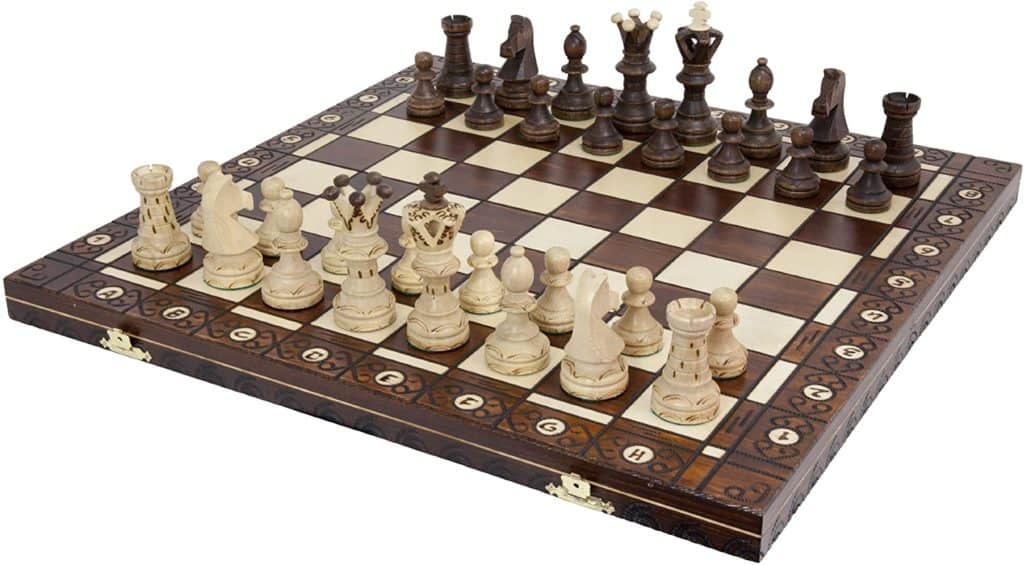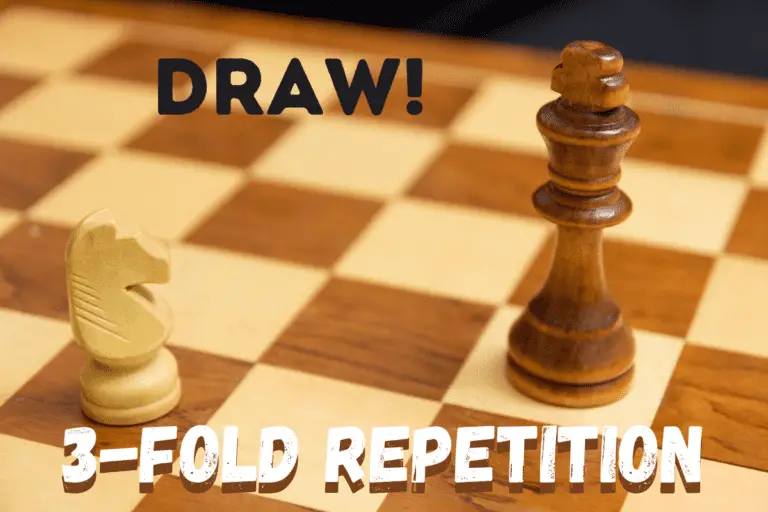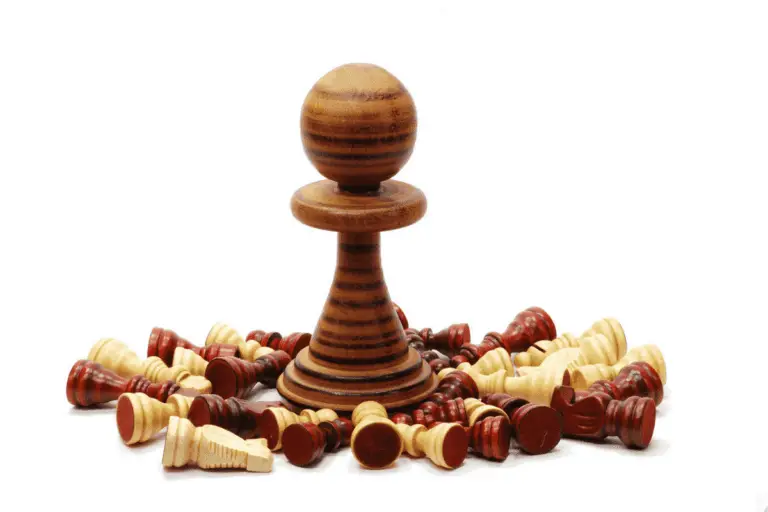Chess Isn’t Hard to Learn (If you do these 11 things)
⭐⭐⭐ Take 14 minutes to read and improve your chess game ➡️ : This article was first published on, and is Copyright of Chessquestions.com
Chess is a game that is loved by many people for its complexity, but also hated by many because of the challenge it presents and often the question is raised, why is chess hard to learn?
Chess is not a hard game to learn in terms of knowing how to play. There are basic rules to understand to get you started, while more complex rules and special moves can be learned as you progress. The more you play and practice, the easier you will find chess to play.
Becoming an expert in chess is not so easy however and will take many years, or even a lifetime to achieve. This post is not about becoming a master, it is about how easy it is to learn chess with a few simple guidelines which I have listed below, step by step.
11 Steps to Make Chess Easy to Learn (& 11 more to improve further)
All too often I hear people ask ‘Why is chess so hard’ when in fact, it isn’t at all. People who find chess hard to learn have either not been shown correctly how to play or not been prepared to learn the basics first.
You have to learn to walk before you can run and the first 11 steps below, are they. Walking into learning the game of chess. Beyond that, #12 to #22 will help your game improve further so that you can start racking up wins both against a friend or family in chess matches, who begin to think you are a genius at the game. From there you can move on to increasing your online chess rating and perhaps play a tournament.
1. Learn the pieces and how they move
Before you can begin to play chess it is important to understand how each of the 16 pieces moves.
You’ll have 8 x pawns, King Queen 2 x Bishops, 2 x Knight, and 2 x Rooks and each has specific rules as to how they can move around the board during chess games.
Children pick up the basics of chess really quickly, beginner adults do take a little longer but spend a little time understanding fully each move and learning chess becomes and developing strategy much easier.
2. Learn About Piece Development
Developing pieces is one of the key elements of playing chess. The movement of one or two pieces many times consecutively will leave you at a disadvantage.
Piece development is when you activate your back rank pieces, Rooks, Bishops, Knights, and Queen from their original starting squares. Another element of chess piece development is castling which I cover next.
When you have a good idea of how best to move your pieces like chess masters, you are beginning to learn this legendary board game and improve.
3. Learn How to Castle and When
The castling move is the only time you can move two of your pieces in one go and involves only the King and one of the rooks. This is not for chess experts, this is a basic move that should be learned early.
There are specific rules as to how and when you can castle, either kingside or queenside, and I would recommend reading my complete guide to castling in chess to understand it fully and improve your skill level in this area.
A couple of hundred words is not enough to explain how to make this special move and when the optimum time to do so is.
4. Learn about Special moves
The castling move is a special move and there are more that will help your chess experience and make learning chess easier.
You have a move called ‘En Passant‘ which is a pawn move that is very different from a standard two-square-first-move or standard single square progression move.
It involves capturing an enemy pawn without landing on the square it is occupying. Again, this can only be done in special circumstances, and you have only one chance to make it.
It can be another key element in learning the game and the attacking options you have with advanced pawns and many chess players either don’t know it or forget to play it.
5. Learn to Fork
The fork is not a special move but when an opportunity to fork two of your opponent’s pieces arises, it can be devastating for them.
Quite simply, you move one of your pieces to a square, generally an undefended one so there is no danger to your piece, but in turn, there is a pattern whereby you will be attacking two or even more of the enemy pieces at the same time.
So that no matter if they move one piece, you will be able to capture one of the others.
Again, there is a lot to learn with forking, not only how and when to make these moves, but also how to identify the opportunity when it arises as well as how to defend yourself against fork attacks too
6. Don’t Rush to Check
Putting your opponent in check is not always a winning move for you, so you should not be in any rush to check the king, especially if you will lose the piece, or put yourself at a disadvantage.
You’ll find competitive chess players will not be looking to make single moves to gain check but will build a pattern of pieces in movement paths all supporting each other before striking.
If you check the enemy king but immediately lose that piece, you will have gained no tempo and not be any better off.
When checking, you should also be considering how you are defending that piece or area of the board
7. Your Pawns are More Valuable The Longer You Keep Them
Many beginners think that pawns are there to be sacrificed. To an extent this is true, but they are also important pieces in your overall strategy understanding this will increase your chess mastery.
Pawns become more valuable the longer the game continues and they form an integral part of protecting your more valuable pieces in the opening and middle game.
Towards the end of the game, if you have more pawns than your opponent, this is what could make the difference between your chances.
If you create passed pawns, you are at a distinct advantage, have could potentially create chances to promote a pawn to another queen. This potential will have your opponent distracted from attacking you and trying to prevent your promotion chances leaving them open to more attacks on the King.
For this reason, never hang your pawns and give them away for free.
8. Learn how to support and defend pieces
The worst thing you can do in chess is ‘hang’ a piece.
Hanging your pieces is when you move one to a square that your opponent can capture and you have no way of capturing them back. You have effectively hung the piece and will lose it.
Your opponent will have won a free piece at no threat to themselves.
It is also good to be able to identify when your opponent might make a similar move and you can win pieces for free from the board, especially pawns.
9. Exchanging Pieces
Now is an opportunity for some time investment learning the value of chess pieces. Each does indeed have a value. Not in that it directly affects an in-game score or position but something to consider when the inevitable exchanges have to take place.
When making exchanges it is important to understand the points value or centipawn value of each piece, even when playing chess for fun.
So when you visualize and plan the exchange or exchanges that you complete the sequence without losing more points than your opponent.
If you can not guarantee a situation where you are level at the end at worst, then you should not initiate, or try to avoid the exchange at this point.
10. Learn How to Checkmate and the Pieces you Need
It is easy to place your opponent in check by directly checking their king, but the way to win a game is to get a checkmate.
Checkmate is a position where your opponent is unable to make a legal move and therefore loses the game.
Depending on the pieces you have retained in the game and are left with, there are some interesting and very helpful mating patterns to learn. Patterns that expert chess players will have learned by heart.
When your opponent has only a king left, or perhaps a king and a couple of supporting pieces and you have a material advantage with perhaps a queen, a rook or a couple of bishops, there are some very specific moves and tactics you can use to achieve checkmate in the shortest possible time.
There are also the quickest checkmates in chess to learn, where you can potentially win a game in just 2 or 3 moves.
They include Smothered Mate, Scholars mate, and Fools Mate, all endings I am sure you have heard of and that beginner chess players will have suffered at the hands of at some point.
It is arguable more important as a beginner if you are finding chess hard to learn, to concentrate on how to finish a game off, rather than some of the complicated opening strategies that can be saved for later.
11. Don’t worry about opening strategy
When people say they find chess hard to learn, often it is because they feel they should learn opening strategies first. The Ruy Lopez, The London System, Queens Gambit, and more.
You have to learn how chess works before trying to learn the complicated permutation of possible opening moves.
Once you have learned the basics, can defend well, and have learned some special moves and attacking strategies, you can come back and start immersing yourself in learning just one or two opening strategies.
Ignoring opening strategy as a beginner will make chess much easier to learn for you.
But I know you want to know, so my advice is to take a look at these 6 easy chess openings for beginners. but not until you have read this entire article.
12. Practice
The most obvious thing on the list but the most important. Without practice, you can never improve.
As you learn new aspects of chess, things I have mentioned previously like fork attacks, mating patterns, and more, the more confident you will become and the more adept at these particular elements of the game.
There are many ways you can practice chess and you can complete all of these playing by yourself
- One Player Chess
- Puzzles
- Drills
- Solo Chess
- Lesson Practice
- Analyse Games
- Practice Openings
Just as important is playing real games of chess both in a friendly manner or competitively over the board or online.
But don’t play too much, it can be counter-productive
13. Don’t Worry About Losing
Losing at chess as in anything is hard to take, but if you can make an emotional detachment from losing when you are learning chess, you will improve much quicker by negating the frustration of not winning.
Your goals at this stage of learning chess should be to be able to successfully make some of the moves you are learning and gain advantages and pieces from your opponent.
By doing so, you will build a knowledge base that you will be able to recall in subsequent games and begin to recognize certain positions and how to play them.
So to make chess easier to learn, don’t make winning your target, make a successful attack or fork of your opponent, the goal.
QUICK TIP: try playing a game right now where you don’t hang a single piece. Play so that every move you make ensure that the piece you move is defended and if taken you can take it back. This does not ensure a win, but you’ll be amazed how many more moves you will be able to make, and you may even find your opponent hanging their own pieces. If they do, only capture if you can do so without losing one of your pieces.
14. Don’t Play Too Much
You may be very keen to spend as much time as possible learning chess and that is fine, the problem comes with playing too many games.
Try to limit the number of actual games you play on a daily basis. Perhaps a maximum of 9 would be a good ceiling level.
When you play too many games, you will ultimately be losing some, you can’t win them all.
When you lose, as mentioned before, if you are not detaching your emotions from the loss, you will be growing in frustration and may then make some crazy gung-ho moves, or worse still, repeat mistakes you have made in earlier losses.
Play only a few games a day, and spend more time studying the theory in chess literature, strategy, and tactics of chess.
15. Join Chess.com
Playing chess online is one of the best ways you can learn chess and chess websites like Chess.com will provide you with a huge number of ways to speed up your learning.
With a huge database of learning tools and categorized areas of chess skills to study and practice, you can test out what you have learned with daily puzzles.
There are daily limits to how much of this information you can access on the site with a free account, but signing up to a premium account is inexpensive and opens up opportunities for much better and quicker learning and chess playing.
And best of all, the mobile app allows you to learn wherever you are from a wide range of chess resources. On the commute to work, in bed, literally wherever you have your mobile device with you.
16. Analyse your games
The beauty of a chess.com premium account is that you will be able to undertake the absolute essential analysis of the games you play.
Analyzing your previously played games will highlight where you made mistakes within the game you played, which moves would have been better.
It will identify and help you avoid
Game analysis will give you an accuracy score. That is, the percentage of times you made the best or a good move and avoided, mistakes, inaccuracies, and blunders, as well as missed mate opportunities.
As you go through the analysis, chess.com will show you where you could have made a better move and give you the chance to try to find it, or you can ask the engine to show you.
At the end of the analysis, you will be given an improved score based on how often and quickly you were able to find the best move.
This game analysis is arguably one of the best ways to learn to play better chess.
17. Limit your Blitz play
Blitz Chess is great but sometimes is not the best way to learn the basics of the game or improve as a beginner.
Time limits add further pressure on your thinking time and will encourage you to make more mistakes as you concern yourself more about the clock counting down and the possible loss to running out of time, rather than making the best moves.
Play daily chess, with much longer time limits when learning chess. It might be slow going, but you will improve quicker and make fewer mistakes, meaning you may even lose fewer games and avoid the frustration of feeling like you are not improving.
18. Set small and achievable improvement goals (Don’t sweat the ELO)
When playing and learning online you will be given an ELO rating which will change subsequent to your game performances.
Don’t sweat this too much and certainly set yourself goals based on trying to improve that score.
Set small and achievable goals in terms of learning and practicing aspects of the game and as you do, your ELO score will look after itself and improve.
Having an ELO of 600 and trying to improve to 1000, is going to take time – A LOT OF TIME< and you may become discouraged before achieving your goals
Make your goals bite-sized and small and reward yourself regularly when you reach them
19. Watch Videos
As well as being super-entertaining you can learn a great deal from watching Chess videos on YouTube.
You’ll be able to watch lessons, more in-depth explanations about different strategies and moves, as well as watching very good players play games and explain what they are thinking not only about their own moves but what they think their opponent is trying to do.
They will go into great detail and you will learn so much they point out what not to do as well as often making the very best available moves.
My favorite YouTube Chess channel is GothamChess. It is so good that Levy, the guy that runs the channel, posted at least one video per day for an entire year and picked up over one million subscribers in that short space of time.
He has various types of videos, all of which you can utilize to make learning chess easier.
20. Read books
It might seem a bit old skool these days to read books about chess, but I would say they can provide an even more important way of learning the game. There is no scrubbing back and forth on a video and trying to find the right place.
With chess books, you can just mark out the bits you might like to return to, and the depth of explanations can be even deeper still.
You will find some of the most famous chess grandmasters of all time have lots of books that can be read, and you can buy them for specific aspects of playing too, including single books covering just one opening theory and all the possibilities within them.
I highly recommend reading chess books to make learning chess easier for you and
some of the best ones I have read and learned from are:
21. Buy a Course
Your first instinct when hearing mention of buying a course to learn chess is, ‘Why, when there is so much free information available on the internet and YouTube?
It is a valid question and you are right, there is a ton of stuff available for free.
However, and I am referring to myself here, but I am sure this applies to many other people too.
When I want to learn something and I use free resources, I kind of lose commitment, focus and find myself lapsing and saying I will return to more later but often don’t.
When I pay for something, I want to extract the most value that I possibly can from the purchase and that is my drive to complete whatever the task is. Whether that be a course for business, a language course, or as is the relevant case here, an inexpensive chess course.
There are hundreds of not thousands of courses to choose from, and whilst that might feel daunting, to begin with, change perspective and understand that it is in fact a gift.
There is far too much to learn about chess to be able to have everything in a single course that will improve every aspect of your game, so select what you want to learn and go from there, whether that be a specific opening, other game strategies or something more in-depth.
This is a superb course that takes you beyond the basics in one all-round package for less than $50

22. Learn Chess Notation
Wow, I nearly forgot this one. But kind of on purpose, because I wanted it to stand out.
One thing a huge number of chess players do not do is learn how to write chess moves. Known as chess notation, it is a special way of writing and recording moves that are made during a game of chess.
It is essential to know how to do this if you want to enter a chess tournament, but don’t leave it until then.
The sooner you learn how to read and write chess moves, the quicker you will learn how to play chess. I’m not going to explain why but will refer you to this article below, take a look, get a little interested and give it an hour or two.
I PROMISE, when you understand how to read the moves, you will become a better chess player, be able to understand online chess instruction and game analysis better and your ELO rating will climb quicker than a rat up a drainpipe.
ChessQuestions.com is a participant in the Amazon Services LLC Associates Program, an affiliate advertising program designed to provide a means for sites to earn advertising fees by advertising and linking to Amazon.com, Amazon.co.uk or Amazon.ca
You Want to be a BETTER CHESS PLAYER but Don’t Know Where to Start
Everyone knows that chess is a challenging game. Even the best players in the world continue to learn and improve their skills.
Garry Kasparov’s Masterclass Chess Course is the perfect solution for you. In this course, Garry will teach you his favorite openings and advanced tactics, so that you can develop your instincts and philosophy as a chess player. With over 20 hours of video lessons, this course is guaranteed to make you a stronger player.
Alternatively, you can sign up for a Masterclass with Gary Kasparov for just $16 per month. And get access to all other masterclass courses at the same time, from Movie Making, Music recording, Cooking, and Health & Wellbeing.
Chess Set
This is a superb Wegiel Handmade European Ambassador Chess Set which is stored inside the board itself. Super high quality, it looks fantastic too
- Wooden 21 Inch Beech & Birch Board With Felt Base
- Carved Hornbeam & Sycamore Wood Chess Pieces
- Compartment Inside The Board To Store Each Piece




![50 Most Common Questions About Chess [Chess FAQs]](https://chessquestions.com/wp-content/uploads/2022/02/Questions-about-chess-768x512.jpeg)



